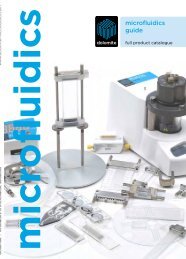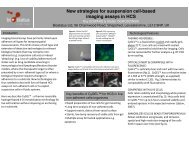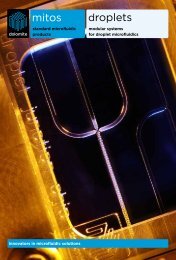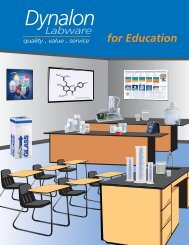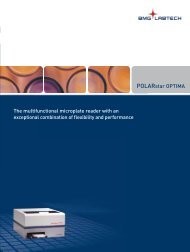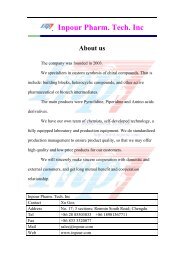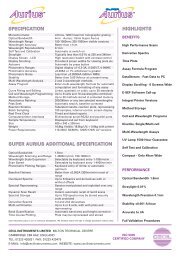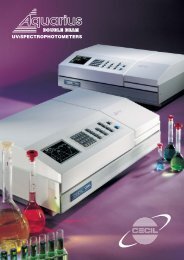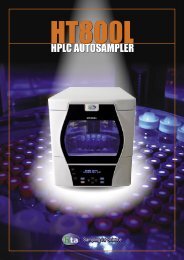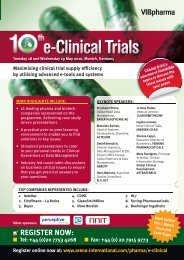connected
Connected - Labhoo.com
Connected - Labhoo.com
- No tags were found...
Create successful ePaper yourself
Turn your PDF publications into a flip-book with our unique Google optimized e-Paper software.
<strong>connected</strong>ICT and sustainable developmentPeter Madden, Ilka WeißbrodApril 2008
acknowledgementsAt Forum for the Future: David Aeron-Thomas,Tom Berry, James GoodmanThank you for comments and thoughts from:Richard Barrington (Sun Microsystems), Ruediger Kuehr(StEP), Paul Miller, Susan Morgan (BT), Sean Nicholson(Microsoft), Sheridan Nye (ICTandclimatechange),Chris Preist (Hewlett Packard), Lorenzo Radice (TelecomItalia), Molly Webb (The Climate Group), Anson Wu,Stephen Young (ICTandclimatechange).Editorial input:Martin Cottingham, Alex JohnsonForum for the Futurecontents1 executive summary 62 introduction 83 making IT 114 using IT 155 applying IT 18working 20travelling 231Forum for the Future - the sustainable developmentcharity - works in partnership with leading organisationsin business and the public sector. Our vision is ofbusiness and communities thriving in a future that isenvironmentally sustainable and socially just. We believethat a sustainable future can be achieved, that it is theonly way business and communities will prosper, butthat we need bold action now to make it happen. Weplay our part by inspiring and challenging organisationswith positive visions of a sustainable future; findinginnovative, practical ways to help realise those visions;training leaders to bring about change; and sharingsuccess through our communications.E: business@forumforthefuture.org.ukT: +44 (0)20 7324 3639www.forumforthefuture.org.ukshopping 25meeting 276 conclusions 29appendix a – policy options forgovernment and business 30appendix b – ICT Sustainability 30initiatives 32references 34Registered office: Overseas House,19-23 Ironmonger Row, London, EC1V 3QNRegistered charity number: 1040519.Company limited by guarantee: 2959712Date of publication: March 2008Designed by IdeasPrinted on FSC Revive 100% recycledSponsored by Sun Microsystems2
<strong>connected</strong>: executive summaryexecutive summaryWe are living through some of the biggest changesthe world has ever seen. The digital revolution istransforming the way we interact - how we live, workand play. At the same time, growing awareness of thesustainability challenges facing our planet is forcingus to ask profound questions about our economyand lifestyles.This paper is about how information and communicationtechnology (ICT) relates to sustainable development. If wedevelop and apply ICT badly, it could add to the world’sproblems. It could devour energy and accelerate climatechange, worsen inequality for those who do not haveaccess and increase pollution and resource use byencouraging ever more frenetic consumerism.If we apply ICT well, the rewards could be enormous.It could help to enhance creativity and innovation tosolve our problems, build communities, give more peopleaccess to goods and services and use precious resourcesmuch more efficiently.We have the capacity – through our decisions on how weproduce, buy, use and apply ICT – to secure enormoussocial and economic benefits. These might includeenergy savings through monitoring and managing energyuse, creating more efficient transport systems, reducingtravel needs through electronic commerce, videoconferencingand other forms of electronic transactions,producing fewer physical products that consume finiteresources and increasing interaction between peopleand organisations.In this document we look at the social and environmentalimpacts of producing ICT and how the negative impactscan be reduced. We look at the sustainability impacts ofusing ICT, particularly its role in energy generation andclimate change. Then we turn our attention to how ICTcould be applied to make a better world.In weighing up the costs and benefits, it is clear that thedirect impacts of ICT are smaller and easier to control.The indirect impacts – on how we live our lives – aremuch greater and more difficult to manage.The sustainability challenges facing ICT businesses arecomplex, just as in other sectors. This should not,however, prevent the ICT industry from dealing with theissues and so reaping maximum benefit. Sustainabilityleadership is necessary if the benefits are to extend rightacross the whole ICT industry.travellingshoppingmeetingworkingthe impactfromusing ITthe impact ICTfrom businessmaking IT3
<strong>connected</strong>: executive summaryIt is up to every one of us to show leadership. Everyone can play their part in this <strong>connected</strong> world. We would like tosee ICT made, used and applied with consideration of the following questions:Are you <strong>connected</strong>?making ITDo you…• Minimise the resources used in manufacturing thehardware?• Maximise the social benefits for workers andcommunities in the supply chain?using ITDo you…• Radically improve the energy efficiency of thetechnologies, reducing energy use overall andincreasing the use of renewable energy?applying ITDo you…• Create wealth and satisfy needs with a lowerenvironmental impact?• Reduce the need for people and things to move,and transport things more efficiently?• Give consumers wider access to cheaper, moresustainable products and services?• Enable people to connect, interact and strengthentheir communities?• Innovate to solve the problems of how we livetogether sustainably - here and across the world?• Ensure re-use, recycling and responsible disposaland address rapid obsolescence?.Above all, we see the application of these newtechnologies as an opportunity to address sustainabilitychallenges creatively. Combining new technologies withsocial and institutional innovation could mean a radicalrethink in the way that companies, governments andindividuals deal with their wider responsibilities.‘Taking the <strong>connected</strong> theme a step further ‘making it’,‘using it’ and ‘applying it’ are all inter-<strong>connected</strong>. MakingICT more efficient will enable people to do more withless. And using ICT more efficiently will effectivelyreduce the impact of the ‘making it’ stage. This couldbe something as simple as replacing a PC after fouryears instead of two. For example, doubling the life of aPC would in effect reduce the impact from making a PCby 50%. And if that PC is shared with another person theimpact will be halved again, effectively reducing theimpact from making one PC by 75%.At first glance this is not good news for the PCmanufacturing industry. But as people’s expectationsgrow and as the world population increases we will haveto do more with less. We can use ICT to ‘dematerialise’the economy. This would mean moving away from abusiness model that is based on products and thingsand towards business models based on services.For example, instead of buying a PC we rent the use ofone – that way the company has a steady stream ofincome without the ‘need’ to sell you a new PC every twoyears. Or instead of buying physical products or makingjourneys we replace them with digital alternatives. Peopledon’t want a computer for itself – they want what it cando and what it can enable them to do.ICT can help to reduce the environmental footprint ofwhat we do. It can facilitate the networks, partnershipsand actions we need to work things out in a complex and<strong>connected</strong> world. The digital revolution could spreadbenefits to all sectors of society and all corners of theplanet, bringing benefits to all regardless of location, age,disability or income.After reading this report, take the time to think about thewider opportunities and how you can use ICT to make theworld a better place. We have left some empty spaces inour picture. You can help fill them in.4
<strong>connected</strong>: introductionintroduction2The goal of creating a sustainable world is a realand pressing one. We all rely for our very survivalon a host of often unnoticed ‘eco-system services’- from a stable climate to assimilation of waste, fromproviding food to controlling disease and pests.The overwhelming scientific evidence is that mostecosystem services are currently being degraded orused unsustainably.“Human activity is putting such strain on the naturalfunctions of the Earth”, says the UN’s EnvironmentProgramme, “that the ability of the planet’s ecosystemsto sustain future generations can no longer be taken forgranted. Many of these eco-system services are at orbeyond limits.” 1It’s not just rainforests and tigers that are under threat.Climatic systems, water resources, agriculture andfisheries are all being degraded. Our current path ofdevelopment is bringing us up against environmentallimits and this could lead to catastrophe.We’re also depleting our natural systems at the very timewhen our needs are growing. The planet is likely to behome to nine billion people by 2050, with just under abillion extra people in the next 10 years alone. And justas we want to continue to drive our cars and buy newshoes, so people in developing countries want that too.We face the twin challenges of reducing inequalitybetween rich and poor nations and having fewerresources to do it with.The information and communication technology (ICT)industry needs to be more aware of the risks andopportunities related to key sustainability issues. It iscertainly in the interest of ICT companies to identify thelonger-term environmental and societal benefits ofsustainable business practice. If this industry wants tosurvive in a rapidly changing world, it will need to be ableto adapt with imagination and vigour.We examined a variety of ICT sustainability initiatives andresearch. It quickly became apparent that thosedeveloping, using and applying ICT would welcome somehelp in understanding the wider context of their concernsand translating this knowledge into the most effectiveaction. This is the purpose of this short paper. Hopefully,by better understanding the relationship between ICT andthe sustainability debate, you can use new technology inways that bring real benefits.the scope of the ICT sectorICT is created by manufacturing and service industrieswhose products capture, transmit or display data andinformation electronically. These can be broken down intoICT goods and services, electronic business/commerce,IT security, digital content and distribution of ICT toorganisations and individuals 2 .In 2006 the European ICT sector accounted for 5.5%of total GDP and employed more than six million people.The sector is expanding, with over 3.5% growth in 2006.Communications technologies are exploding, too.Worldwide the number of phone subscribers has grownat nearly 20% a year over the past five years to aroundtwo billion (about 30% of the global population). Over600 million new phones were sold in 2005 3 .5
<strong>connected</strong>: introductionbeyond the direct impactsAt present a great deal of the research focuses on theimpacts and opportunities created by the existence ofICT and the industry’s processes and procedures. Theseinclude the design, manufacture, operation and disposalof ICT. However, there is a great deal more to ICT thandirect impacts alone. Some of the most important impactscome from how these technologies are applied.Some have recognised this and have begun to addresssustainability in ICT beyond the direct impacts. Forum forthe Future’s own work on Digital Futures and DigitalEurope was an early example of this. More recently, boththe combined WWF and European TelecommunicationsNetwork Operators’ Association (ETNO) initiative and theSaving The Climate @ The Speed Of Light 4 campaignhave adopted Global Reporting Initiative (GRI) language.This divides ICT products and services into three groups:direct, indirect and systemic. In our paper, we have calledthese ‘making it’, ‘using it’, and ‘applying it’. Linked tothese effects are the scale of impacts, the ease ofmeasurement and their ability to influence.impactinformationavailableabilityto influenceDirect effects‘making IT’smalleasy to measureeasy to influenceIndirect effects‘using IT’significanthard to measurerequirescollaborationwith customersSystemic effects‘applying IT’very bigmainly theoriesrequirescollaborationwith customersand governmentFigure 1: Adapted from Saving The Climate @ The Speed Of Light6
<strong>connected</strong>: introductionThe ICT sustainability impact ratio has even beensuggested to be 20:80, where 20% of impacts are foundin ICT provision and 80% in use and application. Thefollowing illustration shows the relationship between ICTbusinesses, the impact of ICT production and use andthe impact of wider application of ICT technologies:workingtravellingshoppingthe impactfromusing ITthe impactfrommaking ITICTbusinessmeetingFigure 2. ICT impacts and sustainability opportunitiesBy choosing a ‘making it’, ‘using it’ and ‘applying it’approach, we hope to make it easier to grapple with theissues and opportunities and so stimulate long-termthinking across the sector. After all, no ICT business canoperate independently of the wider applications of ICTtechnology or the global sustainability context.7
3<strong>connected</strong>: making ITmaking ITYou might just see your computer as a lump of plasticand metal sitting on your desk. We rarely think aboutthe large volumes of earth and rock moved inmanufacturing, the associated disruption or damageto biodiversity, and the huge amounts of energyrequired in the extraction and refinement process.What about the non-renewable nature of some materialsand their relatively short supply? Or the toxic chemicalsthat are sometimes used to extract the metals from theores and the toxic nature of some of the materials mined?What about the associated groundwater and air pollution,and soil contamination?A 2004 United Nations University study has found thataround 1.83 tonnes of raw materials are required tomanufacture the average desktop PC and monitor, aboutequal to the weight of a mid-size car. 5 Furthermore, themanufacturing of a single desktop computer and 17-inchcathode ray tube monitor requires at least 240 kilos offossil fuels, 22 kilos of chemicals and 1,500 kilos of water.Other research suggests that to source the gold in asingle circuit board around 220 pounds of mine waste isgenerated 6 .Then, there is the manufacturing. Computer components– screens, keyboards, batteries, circuit boards and so on– are typically manufactured separately, often in differentlocations and by different companies, before beingassembled. Studies show that the energy used tomanufacture components, in particular, is one of themost critical impacts. The amount of water used canalso be important, depending on the location. Theaverage computer chip requires 45.46 litres of water,used primarily for washing 7 .chemicals in your computer 51• Selenium in circuit boards as power supply rectifier• Polybrominated flame retardants in plastic casings, cables and circuit boards• Antimony trioxide as flame retardant• Cadmium in circuit boards and semiconductors• Chromium in steel as corrosion protection• Cobalt in steel for structure and magnetivity• Mercury in switches and housing.8
<strong>connected</strong>: making ITSome materials are potentially hazardous duringmanufacture. Harmful materials are used in ICTcomponents, including toxic metals in batteries such aslithium and cadmium; lead in cathode ray tubes; andflame retardants on appliance shells 8 . Inadequate wastetreatment facilities can lead to leaks and subsequentenvironmental damage.Global manufacturing and out-sourcing bring ICTcompanies some big advantages. The ability to seek outlower-cost suppliers increases competition and choice,drives down prices and can help deliver continuity ofsupply and new markets.There are, however, additional risks and complexitiesinvolved. Developing countries are a long way away, withdifferent standards and different commercial and culturalrealities. Quality control, traceability and accountabilitycan be difficult to maintain in extended supply chains.There may be undisclosed or unmonitored subcontractingin country. There have been a number of highprofileexposés and campaigns about working conditionsin the electronics industry – from Coltan in the Congo,through working conditions in Mexican factories, to e-waste in India.When a piece of equipment reaches the end of its (oftenvery short) life, it has to be disposed of. The UK isestimated to produce 1.2 million tonnes of e-waste eachyear 9 , which until now has mostly ended up in landfillsites. This is despite the fact that the issue has been amajor driver of legislative activity around the world. Ifwaste is not recycled or disposed of properly, theleaching of metals and chemicals can lead to water andair pollution and the contamination of land.Not all this waste is disposed of responsibly. Some 20 to50 million tonnes 10 of e-waste (including lead, cadmium,mercury and other hazardous substances) are generatedworldwide every year as a result of the growing demandfor computers, mobile phones, TVs, radios and otherconsumer electronics.9
<strong>connected</strong>: making ITOld kit can offer significant potential for providing moreaffordable access in developing countries. But poorernations - with minimal waste management and recyclinginfrastructure and looser environmental regulation -typically have very limited capacity for dealing withelectronic goods when they reach the end of their lives.Old, broken electronic equipment is sometimestransported illegally from the US and Europe – against therules of the international Basel Convention - to developingcountries in Asia and Africa (see www.ban.org). In 2006 asmany as two-thirds of all Nigeria’s PCs imported for reuseturned out to be unfit for purpose 11.And even the working electronic equipment transported topoorer nations is not all that great. The imported older kit,for example CRT screens, is less energy efficient than thenew kit we buy in the Western world. The energy intensiverunning of imported ICT goods exacerbates the alreadyexisting energy poverty.design for environment 51‘Design for Environment’ is design that seeks to eliminate potential negative environmental impacts before aproduct is made. Clearly, it is better to design out waste and problems in the first place, rather than have todeal with them afterwards. This concept involves reducing the quantity and number of materials used in aproduct or service; the resources used in manufacture, operation and disposal; the hazardous materials thatare used; and the quantity of non-recyclable materials used. It also involves modular design that allows forupgrades, easy refurbishment or parts replacement, and simpler dismantling for re-cycling or disposal.Computers can be refurbished and re-used (usually the best option environmentally), taken apart andrecycled, or disposed of (usually the worst option environmentally).10
<strong>connected</strong>: making ITopportunitiesimproving production and disposalThere are opportunities to radically improve how ICT isproduced and disposed of. The industry can reduce theenergy intensity of production and/or increase itsefficiency. It can use more refurbished parts or recycledmaterial and use fewer potentially hazardous materials.One obvious step is to increase the amount of recycledmaterials used. Copper, for example, is a major sourcematerial for ICT products. In 2003 the Wuppertal Institutecalculated that 500 kilos of raw materials are needed toproduce one kilo of primary (super refined) copper. Thisfigure is composed of the materials used in manufacture,the energy consumed, the transport requirements, eventhe cardboard boxes and other packaging of thecomponents. Producing a kilo of secondary (i.e. lessrefined) copper requires only 9.7 kilos of materials – under2% of what is used to make primary copper 12 .reducing demandReducing the relative impact of IT (e.g. reducing theimpact from making one PC by 20%) is important. But,given the projected growth in demand, it is as importantto reduce demand for IT hardware and software. Forexample, doubling the life of a PC would in effect reducethe impact from making a PC by 50%. And if that PCwas shared with one other person the impact would behalved again, effectively reducing the impact from makingone PC by 75%.re-useExtending a machine’s operational life through re-useholds a much greater potential for energy saving thanrecycling. Upgrading PC memory or storage space, ordonating an old computer so that it may continue to beused, can produce potential energy savings of betweenfive and 20 times those gained by recycling 13 .working conditionsAnother important sustainability issue concerns how theworkforce manufacturing ICT products are treated. In2004, the Catholic Agency for Overseas Development, adevelopment organisation, issued a withering report,alleging “dire working conditions” by overseas contractorsserving the computer industry. Many ICT companies arenow paying increasing attention to working conditions intheir supply chains. There are two main cross-industrygroups that try to improve standards. The GlobalElectronics Sustainability Initiative (GeSI) is mainly madeup of European companies, while the Electronics IndustryCode of Conduct (EICC) is mainly supported by USbasedbusinesses. Sustainability leaders are working todrive adoption of EICC throughout their extended supplychains: covering labour rights, environmental health andsafety, working conditions and business ethics.11
4<strong>connected</strong>: using ITusing ITBy 2010 the consumer electronics sector will be thebiggest single user of domestic electricity in the UK.It is projected that ICT equipment and consumerelectronics together will make up 45 per cent of allappliance-related electricity use in the UK home 14 .According to the World Summit for an InformationSociety, electricity demand from the ICT sector forindustrialised countries is between 5 and 10 per cent oftotal electricity demand. An important amount of theelectricity used by ICT is consumed when equipment isswitched off or is not performing its main function. Today,these standby losses are of the order of 50% of theelectricity used by ICT — representing a huge opportunityfor improvement.Data centres and servers are some of the hungriestenergy users. The charity Global Action Plan points outthat growth in data storage has overtaken the growth inthe airline industry. In 2006 48% more data storagecapacity was sold in the UK than in 2005, while thenumber of plane passengers grew by only 3% 15 . Powerconsumption by servers doubled between 2000 and2005 16 and server farms concentrate the use of largeamounts of energy.production and greenhouse gas emissions. Using thepersonal computer as an example, the table below 17illustrates the relevance of the sustainability impacts ofthe use phase in relation to production and disposal.Production Use Disposalphase (%) phase (%) phase(%)Energy used 27 73 not assessedGreenhouse gases 29 68 3Waste 22 65 13The constant evolution of ICT technology shortensproduct lifetimes. New models of computer, phones andserver applications are released, increasing aspiration andconsumption. ICT goods are, of course, not the onlysector where this happens: the same can be observedwith other consumer goods such as clothes and furniture.The average lifetime of a PC is three years. 18 On averageusers replace their mobile phones, which in theory havean average life span of about ten years, every 18 months.In 2004 the European Commission estimated that the EUproduces over eight million tonnes of Waste Electrical andElectronic Equipment (WEEE) per year. 19 And Gartnerestimate 170 million computers were thrown away in2006 alone.Looking at the whole life cycle of ICT, the ‘use phase’ isthe most significant in terms of energy use, waste12
<strong>connected</strong>: using ITopportunitiesefficiency and behaviour changeThere’s no two ways about it - our technologies are goingto have to get more efficient. In order to reduce theimpact of climate change, the UK must reduce itsemissions substantially. The Confederation of BritishIndustry estimates that by 2030, nearly 60% of therequired carbon emissions savings must come from moreefficient energy use at home, in business and in transport.By 2030 electrical products will need to be at least 30 percent more efficient than they are today. 20Some improvements can come from simple behaviourchanges. The National Energy Foundation and Infosourceestimate that over Christmas 2006, UK businesses couldhave saved £8.6m. 21 More than six million PCs were lefton over Christmas, consuming nearly 40 million KWh ofelectricity. Together with the printers and other hardwareleft on, this equates to the same amount of electricityrequired to microwave 268 million mince pies. This pooroffice management is responsible for approximately19,000 tonnes of CO 2 .savings on standbyOther changes need some simple technologicaladjustments. Many commercially used ICT systems areprevented from entering their standby mode by local areanetwork (LAN) traffic, meaning that many PCs andsystems run at full power constantly. Sometimes, this isnecessary for maintenance work – but not always. In 2004the United Nations University in Tokyo 22 suggested theredesign of network cards to allow PCs to go to sleep andpower up again only in the event of any importantnetwork traffic. They estimated that Australia alone couldsave three million tonnes of CO 2 by using presencedetectingservices that turn off devices that are ‘on’ butnot being used. 23using renewable electricityHow do you reduce the impact of your equipment? Youcould get your battery recharged with renewableelectricity. Oxfam now sells the pocket size solarrecharger Freeloader. Once charged, Freeloader’s internalbattery can power an iPod for 18 hours and a mobilephone for over 40 hours. To hook up with the ultimatepower source wherever you are, you might want to investin an Eclipse Solar Gear hybrid notebook case. The solarpanel-encrustedbriefcase, which wouldn’t look out ofplace in a Bond film, charges an auxiliary battery that canalso power devices such as iPods, mobile phones andGPS units. Its integrated cooling system also keeps yournotebook chilled and makes the power last longer.In September 2007 Hewlett Packard launched theSustainable Innovation Zone. Employees are encouragedto submit their ideas and suggestions on how ICTservices can reduce CO 2 emissions. In parallel with theSustainable Innovation Zone, the first billion tons of CO 2reductions using ICT solutions are being mapped byWWF. 2413
<strong>connected</strong>: using ITare you being served?As sexy as a new machine might seem, don’t forget that there are already 1.5 billion PCs in this world - manyalready in landfill, or dumped in Africa as e-waste. Do you really need to buy another one, when you couldsimply extend your computer’s life span?The easiest way to do this is to upgrade the processor, memory or hard disk. The more adventurous cantransform an old computer into a ‘dumb terminal’ with a fast net connection to a powerful server that storesall the data. Apart from the environmental benefits, it’s the ultimate in mobile working - you can access allyour stuff from anywhere. A similar transition has already taken place in the telecommunication sector: mostpeople do not own an answer phone and instead use a voicemail service offered by their network providers.Sun Microsystems, for example, offers access to this dematerialised world of computing with its ‘thin client’product range. A centralised server communicates with a low-energy terminal on your desk, and the systemboasts much lower power consumption than conventional PCs.To take one example, the Strategic Health Authority for London replaced 400 of its 100-watt PCs with SunMicrosystems ‘Sun Ray’ ultra thin client, which only use 4 Watts each. These devices enable all staff toaccess applications and programmes. Not only does the organisation use less energy but otherimprovements also include better air quality and less noise pollution in the office.data centre power and coolingHow do we make data centres less power hungry?A simple solution, such as switching the type of powersupply, can have significant impacts on energyconsumption during operation. Data-hosting companyUltraspeed, for example, says it has reduced its energyuse by 40% through the implementation of two bigchanges to equipment operation. Firstly, the companyswitched from alternative current (AC) power to directcurrent (DC) power, which cut energy use by 30%. Thesecond change was the introduction of diskless servers.Ultraspeed took the hard drive out of each server andnow hosts the data in another location. 25Meanwhile the EvoSwitch data centre, based in theNetherlands, operates on a low-energy cooling conceptthat uses cold air from the outside. This reduces energyconsumption by over 20%. 26adopting universal standardsFurther potential savings could come from thedevelopment of open standards. There are a multitude offormats and standards in the ICT industry. This can makeconsumers’ lives difficult -ever tried to play music filesbought from iTunes on your mobile phone? The variety ofstandards also encourages excessive consumption of ICTgoods. Equally, continuous updates of software packagesthat can’t operate on older PCs is unsustainable.Universally adopted standards would decreaseconsumption and help to make the use of ICTapplications easier for users.14
<strong>connected</strong>: applying IT5applying ITOf course we need to sort out the direct impactsarising from manufacture, use and disposal. Butsome of the biggest wins can arise from applyingthese technologies to other sectors and issues. Inthis section, we look at more general opportunitiesarising from applying ICT. In the four followingsections, we look at how ICT can affect how wework, travel, shop and meet.The internet enables easier access to information. Todaymany more people and households have access to ICTequipment than in the past. As recently as the earlynineties, this was still a new phenomenon. 27 In 2007,however, the number of PCs in use worldwide passedthe one billion mark. 28Our ever-clearer understanding of trends and scientificdata is helping to increase awareness of sustainabilityissues and encourage action. Many of the profoundchanges that threaten our long-term survival, such asclimate change and loss of biodiversity, are brought to ourattention because of sophisticated communicationsnetworks. ICT can play a vital role in collecting such data,and helping us manage the planet’s resources moreefficiently.general opportunitiesimproving environmental efficiencyBy enabling innovation, ICT products and systems canreduce other sectors’ reliance on goods and services.For example, in the music industry the more adventurouslabels and distribution channels now use no materialswhatsoever. Instead there is ‘virtualisation’ – replacing amaterial product with a virtual alternative. MP3 players arenow much more commonplace than portable CD players.This is a good thing. Downloading 56 minutes of musicuses half the resources of buying a CD online and isapproximately 2.5 times as efficient as shopping for a CDon the high street. 29ICTs can also enable people to use less energy.Automated heat management systems in buildings are anexample of this. 30 The ICT-supported management offacilities combined with the use of virtual services is likelyto limit the total energy demand in 2020 significantly. 31user-generated content“Also known as consumer-generated media, usergeneratedcontent refers to various kinds of mediacontent, publicly available, that are produced by endusers.”This definition is taken from Wikipedia, a freeonline encyclopaedia and one of the most well knownexamples of user-generated content. Such onlineapplications could help to solve many of our mostpressing environmental problems. Communities of interestcan coalesce around tackling particular problems.Research has shown that individuals will act to tackleissues like climate change, but they want to know thatothers are acting, too. 32 The net makes such collectiveaction on a mass scale much easier. End-users sharingknowledge is a democratic process, although usergeneratedcontent is contingent on access to the web.15
<strong>connected</strong>: applying ITubiquitous computingWhat does the future hold? In 20 years computers willcertainly be much more powerful than they are today –perhaps by as much as a thousand times. We can alsoexpect rapid developments in a range of different areas oftechnology, from nano-materials with new properties andnew, more efficient ways of producing and storing energy,to robotics, artificial intelligence, medicine and genetics.Research and development activity is already focusingheavily on these areas. What is much less certain is howtechnological developments will be translated intoapplications and products, and how people will want touse them.We will also see more pervasive computing. Countlesstiny computers with significant processing capacity willbe linked by mega-bandwidth wireless networks, usheringin the era of the ‘always on’ internet. In some ways, thisis already starting to happen. Your electronic travel cardcan talk to the ticket barrier on the bus and your mobilephone can search the internet to help guide you to alocal restaurant.It is estimated that by 2010 there will be 10,000 telemetricdevices (RFID chips – see box) for every man, woman andchild on the planet. They will be distributed andembedded in everything - our clothes, our make-up, ourpets, our groceries, our carpets, and even under our skin.Companies and governments will gain instant, detailedfeedback on many aspects of our lives. There are bigquestions as to what pervasive computing will mean forpersonal privacy.In all of this, we will have to be careful not to worsen the‘digital divide’. This term refers to variations in ICT accessbetween people as a result of differences in age, gender,social status or where they live. It is unclear if the digitaldivide is simply a reinforcement of already existingpatterns of social exclusion. On a global scale, it’s worthnoting that the majority of current and future growth in theuse of the internet will be from the Brazilian, Russian,Indian and Chinese populations. 33radio frequency identifiaction tags (RFID)An RFID tag is an object that can be applied to or incorporated into a product, animal, or person for thepurpose of identification using radiowaves. Some tags can be read from several metres away and beyondthe line of sight of the reader.Today a significant thrust in RFID use is in supply-chain management, improving the efficiency of inventorytracking and management.16
<strong>connected</strong>: workingworkingInformation technologies can help us to work smarter.This should mean less wasted time and fewer wastedresources. ICT can help cut energy and resource use,improve environmental productivity and lead to moreefficient ways of doing business.There is an enormous shift taking place in the economy,from industrial production to service-based, knowledgeintensiveindustries. As demand for products and serviceshas become unpredictable and as markets havediversified to become global, the system of massproduction has become too rigid and costly to sustain.Large companies have adopted new business models,often subcontracting to small and medium-sizedbusinesses whose flexibility allows productivity gains forthe large corporations as well as for the economy as awhole. These ‘network organisations’ rely on a largenumber of connections between smaller businesses,where the links can easily be broken and re-made in ashort period of time.opportunitiesjob creation and economic growthThere is a high growth rate for jobs in the ICT sector. ICTplays an increasingly significant role in the Europeaneconomy, growing by over 3.5 per cent in 2006 alone. 34However, due to the fast-changing nature of ICTtechnologies, the jobs created tend to favour highlyskilled staff.new high-tech business systemsICT can be used at all levels, from the optimisation ofsupply chains to the monitoring of office systems suchas air conditioning. Over 50% of the UK’s CO 2 emissionscome from the built environment . There is considerablepotential to save materials through more intelligentprocess control. Industry should promote a shift not onlyfrom products to services but also to services that areincreasingly environmentally sound.In agriculture, for example, ICT is being used to help tominimise waste in a water-intensive industry. TheAustralian info-tech firm National ICT Australia is trialling awireless sensor network to help farmers to optimiseirrigation. Each sensor monitors soil moisture, leaftemperature and evaporation. 35 South Denmark Universityruns a number of research projects looking at howembedding technology in industrial greenhouses mightlead to reduced water, energy and chemicals being usedto grow food.17
<strong>connected</strong>: workingnew business modelsICT can also spawn new business models. Abel & Cole, ahome-delivery service for organic food based mainly ononline ordering, is now one of the largest organic ‘box’providers in the UK. None of its goods is transported byair, and the company sources most of its goods in the UK.The success hasn’t gone unnoticed: in 2007, thecompany got a major private equity injection, whichwill see a further expansion of the business.ICT could usher in a whole new way of exchanging goodsand services. We have already seen the potential of thiswith the phenomenal success of eBay. In future we couldsee more and more people sharing products directly,using ICT to connect up. Examples of this are peer-topeermusic file sharing and freecycle (see our idea for thisarea at www.forumforthefuture.org.uk/lowcarbonliving2022/products/locality). There are sustainability benefits insuch initiatives: joining people up, democratising trade,more opportunities to recycle and reuse. There may bedisadvantages, too, such as more transportation ofgoods, increased packaging and in some cases theencouragement of more consumerism.energy efficiencyICT has a high potential impact on the rational use ofheating energy. Heating accounts for roughly 30 per centof total energy consumption, and the most effectiveconservation measures using physical materials tend onlyto be applied to the relatively small number of buildingsthat are renovated or newly built each year. Some ‘softmeasures’ using ICT (such as intelligent heating systems)have the advantage of being applicable in all buildings,and could therefore have a significant effect. The use ofICT applications for heat management should be a priorityfor future research and development.tele-workingWorking differently can also deliver productivity andenvironmental gains. Commuting, for example, accountsfor around a fifth of all miles travelled. The UK lags behindits European competitors in allowing tele-working andflexitime and benefiting from the energy savings that theycan create. In Germany, Sweden and Denmark, 40 percent of employers have staff involved in tele-working,compared with 20 per cent in the UK. Home workers onlymade up 11 per cent of the total UK workforce in 2005. 3618
<strong>connected</strong>: workingThe social benefits of tele-working include greaterflexibility of working hours and staff being able to spendmore time with their families. The negatives can include areduction of social interaction with colleagues; worse payand working conditions; and a lack of codes of practicefor tele-working. Wider society also has to consider theinexorable creep of business ‘reachability’ that blurs thelines between work time and private life. Sustainability isabout well-being in a holistic sense, and for all thebenefits in business output, productivity and efficiencythat ICT delivers there are questions – regarding privacy,stress, and so on - to be asked about a 24/7 instantaccess culture.Tele-working will have direct environmental benefits only ifit is accompanied by a reduction in office space and noincrease in energy use in the home and private travel.Weekly and monthly public transport tickets could helpsupport home workers. At present employee discountstend to cover longer periods of time and to favour stafftravelling five times per week. An alternative could bediscounted public transport tickets valid for any 10journeys within a 30-day period. 37the benefits of flexible workingBT has reported productivity improvements of 20% where it has introduced ‘smart working practices’. 38Bradford Council has been involved in a pilot scheme to determine the benefits of tele-working. The teleworkersachieved an improvement in productivity of between 11 and 38% (measured as claims processedper hour), with accuracy levels remaining similar. There was also an 80% reduction in absenteeism rates, andworkers reported improved job satisfaction and quality of life. 39Sun Microsystems has audited its ‘openwork programme’ this year. On average each employee benefitsfrom a 2-hour reduction in commute per week. Over one year, this reduction results in 2 tonnes of carbonsavings (including rebound effects) and a personal financial saving of £1,000 in fuel and non-depreciationservicing costs.Swedish company Telia has reduced its CO 2 emissions by 50% in three years by reducing office space,working more flexibly and eliminating all but essential business travel. 40UK workers waste up to 689,000 hours a month waiting in airports. The resulting economic costs areestimated to exceed £450 million per year. 41 Universal wireless access across all public transport would helpto increase productivity.Codes of practice for home working would help business and individuals to maximise the benefits oftele-work. At present Denmark and Ireland are the only countries in Europe with such codes.19
<strong>connected</strong>: travellingtravellingWill virtual traffic replace real traffic? ICT could helpcreate more efficient logistics and distributionsystems. It could also give disadvantaged consumerseasier access to goods and services. On the otherhand, it might mean more delivery movements, moreextended supply chains and longer haulage distances.By 2020 EU truck traffic is expected to increase byanother 40%. Businesses and government are thereforeincreasingly looking into high-tech solutions for supplychainlogistics and warehouse technologies. 42 Moregenerally, e-commerce and travel might not necessarilyresult in lower consumer emissions. For example,although customer journeys to the shops may bereduced, the goods still have to be delivered to thecustomer. What might previously have been one shoppingtrip could be turned into five separate deliveries.opportunitiesbeing thereICT can reduce the need to travel in the first place (thisis partly covered in the tele-working section, above).As electronic communications improve, people willincreasingly be able to experience ‘being there’ withouthaving to move.controlling trafficTelematics can link global positioning satellites (GPS) totraffic-flow systems. This is already done in theNetherlands and has a significant impact on emissionscaused by congestion. During the 2008 Olympics inBeijing telematics will be used; security cameras and taxiswill be networked to reduce congestion.In the U.S., the commercial telematics market is expectedto expand from 2.5 million units in 2007 to 5.8 millionunits by 2009. Fleet benefits from telematics includeincreased productivity, dispatching efficiency, improvedcustomer service, and vehicle, driver, and cargo safety.Wal-Mart currently uses RFID to track trucks, forklifts, andother mobile devices in the U.S. And United ParcelService is testing a mix of active and passive RFID tomonitor vehicle movement and location. 43more efficient freightWhile trucks provide more than three-quarters of inlandtransport, deliveries by train have been estimated to beroughly three times as energy efficient as road haulage.Advanced delivery systems for long distances (i.e. over600 kilometres) cut fuel use and greenhouse gasemissions by 65%, compared to truck transport. 4420
<strong>connected</strong>: travellingTransport providers should be encouraged to share theircapacity much more. Lorries too often travel empty in onedirection, and distribution depots could be used moreefficiently. One example of how improvements can bemade is the scheme that the British Airports Authority ranat Heathrow to consolidate all deliveries. At the start ofthe project, some 400 vehicles were delivering goods toretailers each day, causing massive congestion andpollution. Now deliveries are done in shared vehicleswhich are loaded to 90 per cent of capacity and there hasbeen a significant reduction in the number of vehiclemovements as a result.A new vision for public transportMore research and resources should be committed toexamining and using intelligent transport systems tosupport seamless, multi-modal public transport. There isalso a need to widen access to ICT-supported workingduring train, bus, boat and plane travel and to makepublic transport more attractive through the use ofelectronic information systems (such as displays at busstops that communicate projected arrival times). ICT’sefficiency improvements in transport must be combinedwith demand-side management in order to ensure anoverall reduction of environmental impact.next-generation video conferencingVirtual meetings can save on travel time and the environmental costs of passenger transport. Until recently,video conferencing facilities were unreliable and often produced poor sound and visual quality.High-definition video conferencing systems that run over standardized IP networks offer better results. Thisall-new video conferencing has already proven its increased user-friendliness.For example, Dreamworks in the US and Bristol-based Aardman Animations used a high-definition system towork on the Wallace and Gromit films. They wanted something that would be good enough to let creativepeople work together to produce a Hollywood movie, without continually getting on planes.Procter & Gamble US found that its new 17 high-definition end points are much more used than theconventional video conferencing system end points.Of course, the high-resolution facilities still require the installation of end points, hence the acquisition of anew piece of ICT kit. However, if these new end points are used regularly and replace highly carbon-intensiveflights – what’s not to love?21
<strong>connected</strong>: shoppingshoppingThe chances are that you’ve bought something on-linerecently – or at least checked out prices. The internetis certain to play a major role in shaping the future ofshopping in the UK. In 2006 online retail spending inthe UK grew by 33.4 per cent to a record £10.9 billion,almost 13 times faster than the retail sector overall. Inan age of growing congestion, and of families in whichboth partners work long hours, internet shopping issure to have a growing role.ICT has changed the way that businesses interact withtheir markets and consumers. ICT has also empoweredconsumers and enabled greater corporate accountability,changing the balance of power between companies andconsumers. The most obvious consumer benefit is thepotential to find cheaper products easily by comparingprices at the click of a mouse. ICT has also supportedthe emergence of green consumerism – it is easieronline to track down ethical products that are notwidely available.opportunitiesenriching the retail experienceAs yet online retail is in its infancy. The range ofpossibilities for a richer consumer experience is onlystarting to emerge. We can anticipate innovations suchas webcams showing the flock of sheep your lambcame from: entering your postcode for local sourcingor very personalised ordering (“sell me the ingredientsfor a gourmet dinner with pork chops”).Online shopping provides an opportunity to reduce theenvironmental impact of retail, as well as increasingchoice, information and targeting. But consumers couldalso use the internet to do things themselves, by tradingpeer-to-peer or sourcing directly from suppliers orindependent providers. Niche markets could explode,as prophesied in Chris Anderson’s The Long Tail. 4522
<strong>connected</strong>: shoppingharnessing consumer consciousnessOnline product information is potentially empowering toobecause it allows more informed purchasing decisions.It can also improve corporate accountability; companyinformation is more widely accessible than ever beforeover the internet. Stakeholders can easily look into acompany’s environmental and social records andpressurise businesses via online movements.In 2005, for example, influential blogger Jeff Jarviscriticised Dell’s customer service. The online communitypicked this up, and many individuals shared their ownstories of negative experiences until the mainstreammedia became aware of these concerns and started toreflect them. Dell responded with the Dell2Dell blog togive consumers a chance to feed back their experiences.This initiative was very successful and has been praisedby Jarvis himself.retail futuresMany people already shop online and have products delivered to their door. This could grow and evenbecome fully automated, as technology allows retailers to know what people want and when they want it.This has a number of benefits from a sustainability perspective. As with supply chains, mass customerdelivery can boost storage and transport efficiency. Advanced ordering means less likelihood of waste inthe supply chain. It also reduces the need for the excess packaging used to sell many products fromsupermarket shelves.However, these benefits need to be carefully balanced with some potential disadvantages. There are asignificant number of people who either don’t have access to the internet, or can’t or don’t want to use it. Astechnology develops, this digital divide could become more stark. The social value of physically going to theshops is part of community life for which some people have no substitute. If internet-based automation leadsto fewer physical shops - as it may - and if retail sector margins are squeezed as a result, the environmentmay benefit but food deserts 46 could develop while community hubs disappear.Retailers need to ensure that all groups, including disadvantaged groups in society, have access to theirservices. They will also need to be mindful of the social role that their physical spaces currently play.23
<strong>connected</strong>: meetingmeetingCan ICT help to build a more inclusive society? Despitefears that the e-revolution would contribute to theerosion of social relationships and undermine localcommunities, there are plenty of examples of theopposite happening. Many people have establishedonline relationships in addition to, rather than insteadof, existing social networks. Sometimes this occurs vianew forms of virtual community, more often throughstrengthening existing patterns of social interaction.Online communities can influence how people work andsocialise. Examples of such communities includeMySpace, Facebook and LinkedIn.Business reputations can be affected by social networksbecause there is easy communication betweenconsumers in instances where businesses used to beable to feed information to the consumer withoutcontradiction. Another challenge these networks havecreated is that businesses may struggle with employeesusing social networking sites during working hours.Will this increase diversity or is everyone becoming thesame? Large-scale use of ICT enables people in differentlocations to communicate on a regular basis. This hasresulted in the creation of a diverse online community.But online communities tend to communicate in only onelanguage: English. This means that some of the potentialfor cultural exchange and learning is not being realisedand language diversity is being undermined.one climateOneClimate is a not-for-profit initiative to bring people together to tackle climate change. For example, ithelps plug people into the international climate change negotiations from across the world. The peoplebehind it say that “climate change is providing humankind with one final and convincing opportunity: a wakeupcall to persuade us, as nothing ever has before, that we must act together to bring about a fair andsustainable world”.oneclimate.net provides innovative spaces and useful tools to enable you to communicate your experiences,insights, questions and answers about climate change. Almost all the content is provided by users.24
<strong>connected</strong>: meetingopportunitiesonline communitiesICT enables people to establish a connection with thosebeyond their immediate circle through networkingwebsites.For example, Sun Microsystems encourages itsemployees to collaborate and disseminate information.The business has over 4000 active bloggers including theCEO and the Sun Foundation uses facebook as itsprimary networking tool.Interaction online often encourages interaction off-line,and this might help to re-establish local communitiesrather than obliterate them. Much research on the socialrole of ICTs has so far focused on the internet but mobilephones play a significant role in social networks too.Surveys in South Africa and Tanzania concluded thatmobiles were facilitating participation in existing socialnetworks, including participation in community groupactivity. 47consultation and collaborationICT can be used to communicate, collaborate and shareideas easily over long distances, allowing people to worktogether in new ways and changing how knowledge isexchanged. We may even see a resurgence of civicculture worldwide as ICT enables online consultations andvoting processes. However, this relies on reliable andcheap access to hardware and internet services.25
<strong>connected</strong>: conclusions6conclusionsThe ICT sector faces extremely complex sustainabilitychallenges. However, as this paper indicates, thereare also lots of opportunities. If these are exploitedeffectively, the industry will become more sustainableand can play a valuable role in enabling other sectors,industries and ultimately the consumer to playtheir part.Clearly, how we use ICT is crucial to the sustainabilitypotential of ICT products and services. The use of toxicmaterials and energy during production of ICT goodsmust be reduced. But what use are these reductions if thelifetime of these goods is shorter than two years?The significance to sustainability of the ‘use phase’highlights the importance of engaging with both thebusiness and private consumers of ICT products andservices. ICT has the capacity to contribute to globaleconomic growth via increasing accessibility and lowerpricing. However, this benefit will be of little consequenceif the challenges of improving working practices, usephases and processes are not addressed.Engaging with the consumer can be a complex activity forbusinesses. This is also true of incorporating sustainableICT solutions into business models. But both must bedone if maximum benefit is to be realised. As outlined inthe introduction of this paper, it is easy to focus on thedirect impacts and opportunities of ICT. However, themost significant area from a sustainability perspective isassociated with the indirect and systemic effects (alsocalled second-order and third-order impacts oropportunities). Through engaging consumers, educatingusers and developing a dialogue between ICT businesses,these issues can be overcome.machines with a missionThe UK-based www.climateprediction.net is running a wide variety of climate modelling calculations - onhome computers. Special software was developed to do this in ‘background’ mode, whenever a machine isswitched on but not using all its processing power.Seven million low-cost laptops are heading for the developing world as the One Laptop Per Child initiativecomes to fruition. Robustly made with a rubberised finish, they’ll run on open-source software. They will alsouse piggy-back wireless networking so that users can contact each other independently or share one internetconnection. Consuming only seven watts, they can run for ten minutes on one minute’s hand-cranking power.In India there is a new initiative to increase the use of information technology among rural and poorercommunities. Promoted access devices include Mobile phones, information kiosks and resource centres areamong the means being used to broaden ICT access. The country’s first national virtual congress for womenfarmers is evidence of the kind of progress being made. 4826
<strong>connected</strong>: conclusionsIt is abundantly clear that ICT can have huge benefits. Butwe mustn’t underestimate the rebound effect – thepotential for all the extra environmental ‘space’ created bynew technology to be swallowed up by our insatiableappetite to consume ever more exotic products, to travelto ever further destinations, to experience new things.Wide-reaching policies with sustainable development attheir core are needed to enable all players in the ICTsector to make the most of sustainability opportunities.For example, businesses encouraging tele-working mightfoster higher productivity, happier employees and reducedcongestion, hence fewer CO 2 emissions. However thesegains could be wiped out if freed-up capacity is simplyfilled by others who fail to adopt sustainable ICTpractices. Staff, whilst able and willing to make changesto their personal behaviours, may find it impossible to doso in the work place.It is up to every one of us to show leadership. We wouldlike to see ICT made, used and applied in such a way thatwe really do connect.Are you <strong>connected</strong>?making ITDo you…• Minimise the resources used in manufacturing thehardware?• Maximise the social benefits for workers andcommunities in the supply chain?using ITDo you…• Radically improve the energy efficiency of thetechnologies, reducing energy use overall andincreasing the use of renewable energy?applying ITDo you…• Create wealth and satisfy needs with a lowerenvironmental impact?• Reduce the need for people and things to move,and transport things more efficiently?• Give consumers wider access to cheaper, moresustainable products and services?• Enable people to connect, interact and strengthentheir communities?• Innovate to solve the problems of how we livetogether sustainably - here and across the world?• Ensure re-use, recycling and responsible disposaland address rapid obsolescence?.Above all, we see the application of these new technologies as an opportunity to address our sustainability challengescreatively. Now it is up to you.27
<strong>connected</strong>: appendixappendix a policy options for government and businessMaximising key sustainability characteristics of ICT will depend on the level of co-operation between government,business and NGOs to implement these policies. The table below 49 shows the policy tools that are open to governmentand business.Policy tool Explanation Primary focus Policy examplesFrameworks A broad statement of goals Affect development at all The EU has started to takeand strategy which establishes sustainability opportunity a lead with incorporating i2010the direction for more specific levels by changing strategic into the 7 th Frameworkpolicy measures. lines of thinking and creating Programme (2007-13). 5028a fertile environment for newpolicy initiatives.This creates new policyinitiatives and legislationto promote the positiveimpact of ICT onsustainable development.Marked-based Market-based policies, Market-based policies may Tax exemptions could bepolicies such as fiscal instruments, create incentives to reduce offered to employersoffer a way of promoting negative environmental purchasing computerssocial and environmental and social impacts, whilst for use by employeesconcerns by reallocating promoting a dynamic, at home. This wouldthe burden of taxation. At competitive ICT promote digital inclusionthe same time, they promote sector in Europe. and create opportunitiesinnovation and stimulatefor home working.new markets.Regulation Public authorities mandate Regulation can reduce The 2006 revised EUthe social and environmental environmental and social directive on universalstandards to be achieved, or impacts. However, regulation services access couldthe technologies to be used, offers less flexibility than be reinterpreted toby firms. market-based incentives promote universal accessand so market-based to broadband.incentives should beMember state governmentsfavoured where possible. could increase fines forheavy-metal contaminationin order to encourageindustry to replace toxicsubstances in productionVoluntary Firms make a commitment Voluntary initiatives can go ICT companies could commitindustry to improve their performance a long way. However, the to exceeding the requirementsinitiatives beyond strict legal stipulations. overall environmental and of the WEEE directive forThis is commonly referred to as social impact depends on recycling electronic waste incorporate social responsibility. industry-wide buy-in. order to reduce environmentalimpacts of ICT equipment.The ICT industry could putforward targets for efficiencygains as part of an industry-wide strategy for reducingenvironmental impact.
<strong>connected</strong>: appendixPolicy tool Explanation Primary focus Policy examplesMonitoring Firms commit to transparency Over time, benchmarking ICT companies could commitand reporting and accountability in their may promote sustainable to triple-bottom-lineactivities. This allows development across the reporting under the Globalbenchmarking across industry, whole ICT sector. Reporting Initiative.which can improve long-termThe ICT industry couldperformance.co-operate with NGOs andpolicymakers to develop sectorspecificguidelines for triplebottom-linereporting.Government- Information and financial Government-supported Government could finance andsupported support is offered by initiatives could improve support social partnerships toinitiatives different public authorities knowledge of sustainability tackle the digital divide.to promote sustainable issues among business and Local and regional governmentsdevelopment. create incentives for could provide financial supportimproved environmental for online local communities,and social performance. particularly in rural anddisadvantaged communities.appendix b ICT sustainability initiativesSaving the climate @ the Speed of LightThis is a joint WWF-ETNO initiative. Formed in 2004, it is a project that provides a ‘road map’ for reducing CO 2emissions in the EU and beyond. This road map aims to close the gap between academic studies on the environmentalimpacts of ICT and the policy making. The full road map is available for free download atwww.panda.org/news_facts/publications/ict/index.cfm .The Global e-sustainability Initiative (GeSI)This is an initiative of ICT companies to improve the global environment and support sustainable development bypromoting business practices and technologies that save energy, minimise waste and help bridge the digital divide.GeSI is supported by the United Nations Environment Programme (UNEP) and the International TelecommunicationsUnion (ITU) and was launched in June 2001 - see http://www.gesi.org/The Electronic Industry Code of Conduct (EICC)Created in 2004, this is a code of best practice adopted by nearly 30 major electronics brands and their suppliers. Thegoal is to improve conditions in the electronics supply chain. Co-operating with GeSI (see above), the group is creatingand implementing a set of tools and methods with the aim of ensuring the standards in the Code are upheld throughoutthe electronics supply chain (http://www.eicc.info/downloads/EICC_FAQs.pdf).The Green GridSet up in 2007, the Green Grid is a consortium of over 100 members - information technology companies andprofessionals - seeking to improve energy efficiency in data centres around the globe (http://www.thegreengrid.org/).i2010This is the European Commission’s strategic policy framework laying out broad policy guidelines for the informationsociety and the media in the years up to 2010 (http://ec.europa.eu/information_society/eeurope/i2010/index_en.htm).WEEE Directive (Directive 2002/96/EC)The Waste Electrical and Electronic Equipment Directive is the EC directive on waste electrical and electronicequipment. It came into force in February 2003. It sets collection, recycling and recovery targets for all types of29
<strong>connected</strong>: referenceselectrical goods. The directive assigns responsibility for the disposal of waste electrical and electronic equipment to themanufacturers of such equipment (http://ec.europa.eu/environment/waste/weee/index_en.htm).The RoHS regulation (Directive 2002/95/EC)RoHS stands for ‘Directive on the Restriction of the Use of Certain Hazardous Substances in Electrical and ElectronicEquipment’. The RoHS directive is closely linked to the WEEE directive and took effect on 1 July 2006. It restricts theuse of six hazardous materials in quantities exceeding maximum concentration values in the manufacture of varioustypes of electronic and electrical equipment. The materials covered are lead, mercury, cadmium, hexavalent chromium,polybrominated biphenyls (PBB) and polybrominated diphenyl ethers (PBDE) - seehttp://www.rohs.eu/english/index.htmlEco labels promoting environmentally sound ICTBlue Angel labels apply to monitors /system units and portable computers (http://www.blauerengel.de/englisch/navigation/body_blauer_engel.htm).The European Commission eco-label applies to personal andportable computers. (http://ec.europa.eu/environment/ecolabel/pdf/marketing/brochures/personal_c_brochure.pdf)references1 United Nations Environment Programme. Millennium Ecosystem Assessment. Ecosystems and Human Well-Being: Synthesis. Washington, DC (2005): Island Press.2 Organisation for Economic Co-operation and Development. Working Party on Indicators for the InformationSociety. March 2007. Information-economy sector definitions based on the international standard industryclassification (ISIC 4).3 Nokia. Integrated product policy project: Stage 1 Final report: Life Cycle Environmental Issues of mobile phones.April 20054 ETNO and WWF. Saving the climate at the speed of light. First road map for reducing CO2 emissions in the EUand beyond. 20065 Williams, M. Think upgrade before buying a new PC. Infoworld (IDG News Service), March 7 2004 -http://www.infoworld.com/article/04/03/07/hnunstudy_1.html; accessed 27 September 2007.6 Earthworks. Recyclemycellphone.com; cell phone recycling report card. May 20067 Fuchs, C. Environment, development and sustainability - The implications of new information and communicationtechnologies for sustainability. Published online on 7 July 2006, http://www.springerlink.com/content/102874/8 Forum for the Future. Earth calling – The environmental impacts of the mobile telecommunications industry.Cheltenham (2006): Forum for the Future.9 BBC News. ‘The mechanics of e-waste recycling’. BBC News Online, 3 July 2007.10 UNEP press release. ‘Call for global action on e-waste’. 1 December 2006.11 BBC News. ‘Nigeria fears e-waste toxic legacy’. BBC News Online, December 2006 -http://news.bbc.co.uk/1/hi/world/africa/6193625.stm12 Alakeson, Aldrich, Goodman, Jorgensen. Making the net work – sustainable development in a digital society.Middlesex (2003): Xeris Publishing.13 Williams, M. Think upgrade before buying a new PC. Infoworld (IDG News Service), March 7 2004 -http://www.infoworld.com/article/04/03/07/hnunstudy_1.html; accessed 27 September 2007..14 Owen, P. The ampere strikes back - How consumer electronics are taking over the world. London (2007): EnergySaving Trust.15 Global Action Plan. An inefficient truth. London (2007): Global Action Plan.16 McKenna, P. ‘Can we stop the internet destroying our planet?’ New Scientist, 3 January 2008.17 Atlantic Consulting and IPU. LCA Study of the product group personal computers in the EU Ecolabel Scheme..(1998): Altantic Consulting and IPU.18 Predd, P P. ‘How PC is your PC?’ IEEE Spectrum, Volume 42, Issue 1, January 2005.19 European Commission. Nanotechnologies and nanosciences, knowledge-based multifunctional materials andnew production processes and devices. 22 March 200430
<strong>connected</strong>: references20 CBI. Climate change: everybody’s business. London (2007): CBI Climate Change Task Force.21 Thompson, W. ‘Turning off the digital world’. BBC News Online,15 December 2006. -22 Williams, M. Think upgrade before buying a new PC. Infoworld (IDG News Service), March 7 2004 -http://www.infoworld.com/article/04/03/07/hnunstudy_1.html; accessed 27 September 2007..23 Mallon K, Johnston G, Burton D, Cavanagh J. Towards a high-bandwidth, low-carbon future:Telecommunications-based opportunities to reduce greenhouse gas emissions. Sydney (2007): Climate Risk.24 Identifying the first 1,000,000,000 tonnes of CO2 emissions using ICT solutions. Godalming (2007): WWF.25 Financial Times Digital Business Special Report. ‘An IT audit highlights waste’. 3 October 2007.26 Datacentres.com. ‘The first data center to operate entirely climate-neutral’. 7 May 2007.27 Data taken from Anderson, Brynin, Gershuny and Raban. Information and communication technologies insociety. London (2007): Routledge.28 Computer Industry Almanac Inc. PCs in use reached nearly 1 billion in 2006. USA accounts for over 24% of PCsin use. September 2007.29 Digital Europe Project Report. The social and environmental impacts of digital music: a case study with EMI.July 200330 See American Council for an Energy-Efficient Economy. How can the high-tech sector help the EU to achieve itsgoal of reducing energy consumption 20% by 2020? Washington, DC (2007): ACEEE.31 Casal, Van Wunnik, Sancho, Burgelman, Desruelle. How will ICTs affect our environment in 2020? In Foresight,volume 7, issue 1, 2005.32 Sustainable Consumption Roundtable. I will if you will. March 200633 Computer Industry Almanac Inc. ‘Worldwide internet users top 1.2 billion in 2006. February 2007.34 i2010 Annual Report 2007. UK fact sheet. Accessed October 15 2007. The sector growth refers to growth atconstant prices.http://ec.europa.eu/information_society/eeurope/i2010/docs/annual_report/2007/country_factsheets/2007_factsheet_uk.pdf35 New Scientist. ‘Watering crops in the wireless age’. 25 February 2006. See also http://nicta.com.au/36 Bolger, A. ‘Broadband spurs rise in number of techno commuters’. Financial Times, September 3, 2007.37 Such a system has already been suggested in Alakeson V, Aldrich T, Goodman J, Jorgensen B. Making the network: Sustainable development in a digital society. Middlesex (2003): Xeris Publishing.38 Bolger, A. ‘Broadband spurs rise in number of techno commuters’. Financial Times, September 3, 2007.39 SusTel Project Report. Is tele-working sustainable? An analysis of its economic, environmental and socialimpacts. (2004): SusTel.40 Financial Times Digital Business Special Report. ‘Need to take a holistic approach to sustainability’. 3 October2007.41 BT. Your guide to wireless cities. London (2006): British Telecommunications.42 American Council for an Energy-Efficient Economy. How can the high-tech sector help the EU to achieve its goalof reducing energy consumption 20% by 2020? Washington, DC (2007): ACEEE.43 Fleet Financials. Fleet Telematics Becoming a ‘Must-Have’. February 200744 US Environmental Protection Agency. A glance at clean freight strategies: intermodal shipping. EPA 420-F-03-026. Washington, DC (February 2004): EPA.45 Chris Anderson. The Long Tail. July 200646 A ‘food desert’ is an urban area with little or no access to fresh fruit and vegetables and other foods needed tomaintain a healthy, balanced diet. Inequalities widen in food deserts because the poorest residents are least likelyto have the means to secure healthier food by shopping online or travelling outside the area.47 Waverman, Meschi and Fuss. Africa: The Impact of Mobile Phones. Vodafone Policy Paper Series 2 (March2005).48 BBC News. ‘India’s greener IT revolution’. BBC News Online, 22 January 200849 Adapted from EITO: The impact of ICT on sustainable development. Berlin (2002): European InformationTechnology Observatory.50 European Commission. ICT - information and communication technologies. A theme for research anddevelopment under the specific programme ‘Cooperation’ implementing the Seventh Framework Programme (2007-13) of the European Community for research, technolog51. Information from Greenpeace31
Forum for the Future - the sustainabledevelopment charity - works inpartnership with leading organisations inbusiness and the public sector. Our visionis of business and communities thriving ina future that is environmentallysustainable and socially just. We believethat a sustainable future can be achieved,that it is the only way business andcommunities will prosper, but that weneed bold action now to make it happen.We play our part by inspiring andchallenging organisations with positivevisions of a sustainable future; findinginnovative, practical ways to help realisethose visions; training leaders to bringabout change; and sharing successthrough our communications.www.forumforthefuture.org.ukISO 14001 EMS 5952632





